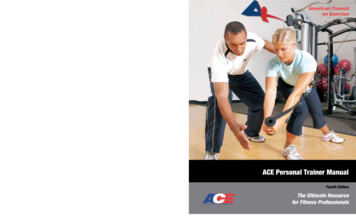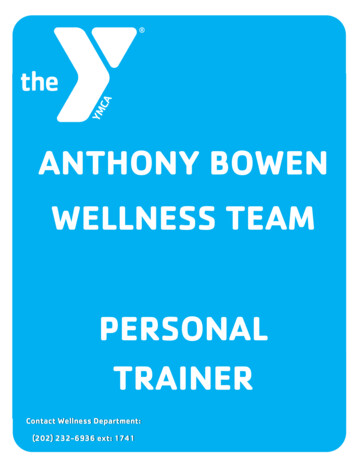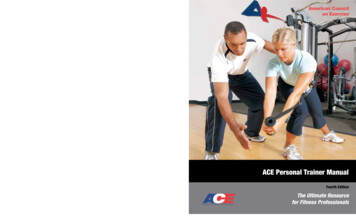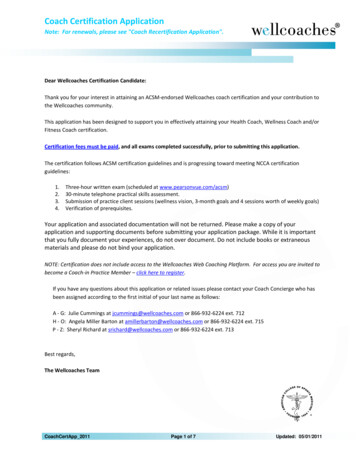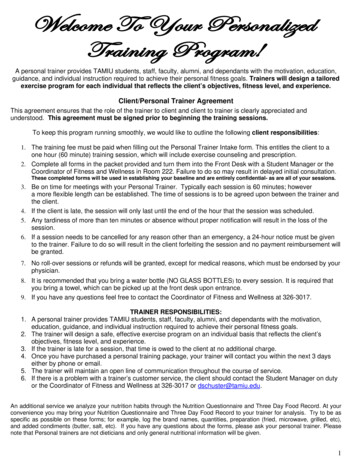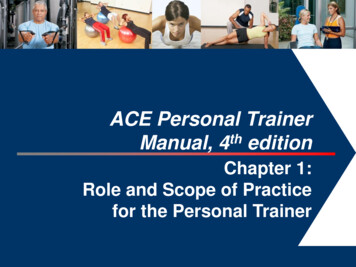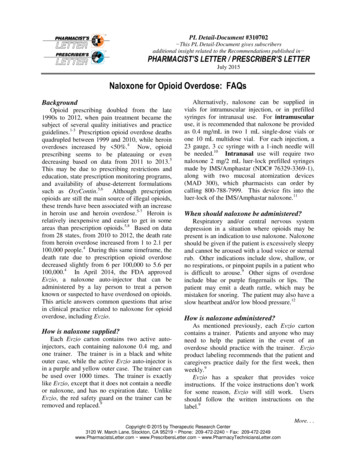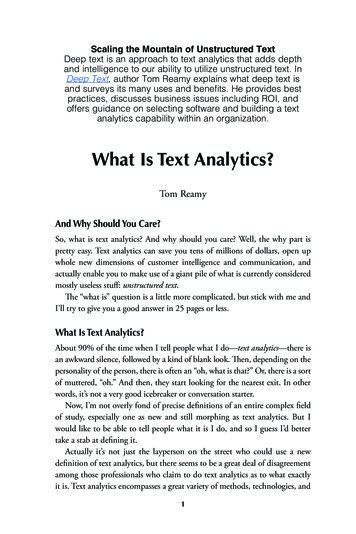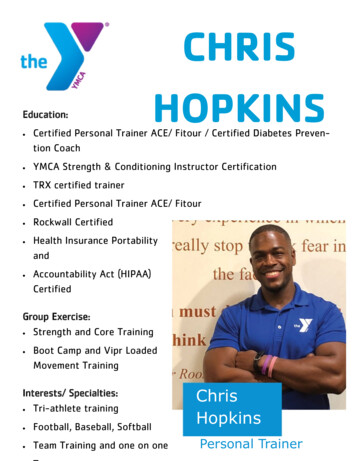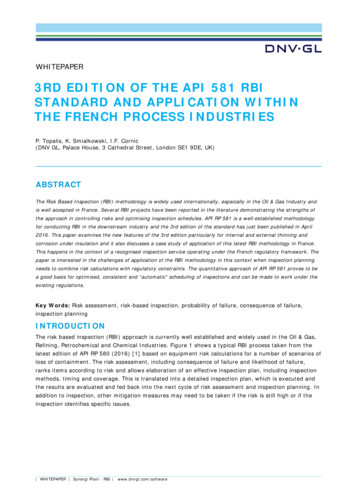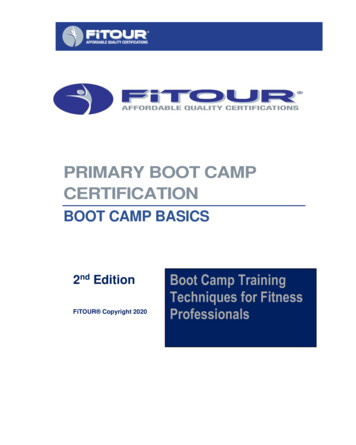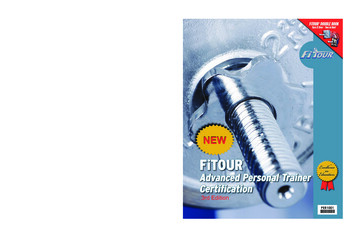
Transcription
NEWNEW
FiTOUR AdvancedPersonal TrainerCertification Coursewww.FiTOUR.comQuality Fitness Education at an Affordable Price! 2005 by FiTOUR . All Rights Reserved. Updated 2013
Welcome to FiTOUR Providing Fitness Professionals with Affordable Quality Education for Over 25 Years.FiTOUR EXAMDirections, Information & Rules*You are about to begin studying for the FiTOUR Advanced Personal TrainingCertification or AFAA CEC Course.This manual will cover the material for bothexaminations.*Certification & CEC Course Exam Access:We encourage registrants to study thematerial, complete the chapter review worksheets, and prepare to take the examination within 90 days ofregistration. You have one full year from date of purchase to access the Certification Exam andthe CEC Course Exam.*Certification & CEC Course Materials Online The online study manual and theonline video are located in your account with FiTOUR in your Study Center. The video follows along withthe manual.*Certification & CEC Course Timed Exam When you have completed the studymaterials and are prepared to take the online exam, log into your Fitour account, click on “Exam Center”and choose the correct exam. This is a timed 3 hour exam that you must complete within the timed 3 hours.You cannot start and stop the exam. Link to the FiTOUR Online Exam UserGuide: ification CertificateOnce you take and pass the certification exam, you can print thecertificate of certification yourself or have FiTOUR mail you a certificate by logging into your account withFitour , click on Certifications and choose certificate option.*CEC CertificateOnce you take and pass the cec course exam, you can print the CEC Certificateyourself by logging into your account with Fitour , click on CEC Course Credits and print.
*Certification Exam FailedIf you do not pass the exam with a 75% or higher you canpurchase a Retest for 25.00 at www.fitour.com/retest*CEC Course Exam FailedIf you do not pass the exam with a 75% or higher you canpurchase a Retest for 25.00 at https://www.fitour.com/retest/cec*Certification RenewalFiTOUR Certifications must be renewed every two years. You willpurchase a 25 online FiTOUR Cec course to renew. Renewal information is availableat http://fitour.com/renewal*Submitting CEC CertificateFiTOUR CEC Certificate with course number; per providerregulations; certificate must be submitted by customer to AFAA within the appropriate time set by AFAAapplicable for AFAA certification renewals.*FiTOUR certifications are nationally recognized and are accredited by the American Council onFitness Education, http://qualityfitnesseducation.com
Advanced Personal Trainer Certification CourseContentsContents . iiiMotivation and Goal Setting . 1¾ Three Types of Motivation. 1¾ Goal Setting . 1¾ Transtheoretical Model of Behavior Change . 3¾ Three Basic Psychological Needs. 6Exercise Psychology and Behavioral Science . 10¾ Definitions: . 10¾ Physical Benefits of Physical Fitness . 10¾ Psychological Benefits of Physical Fitness . 10¾ Exercise Adherence and Compliance . 10¾ Effects of Exercise on Mood . 11¾ Overtraining Syndrome (See Page 34) . 11¾ Body Image/Obsessive Compulsive Disorder (OCD) . 11¾ Common Eating Disorders . 12¾ Muscle Dysmorphia (Reverse Anorexia). 12Advanced Functional Assessments . 15¾ Functional Strength . 15¾ Functional Flexibility . 17¾ Muscle Coordination . 19¾ Muscle Balance/Imbalances . 19¾ Postural Alignment . 21¾ Postural Misalignments . 22Fitness Performance Components and Measurement . 24¾ Agility . 24¾ Speed . 25¾ Power . 26¾ Reaction Time . 27¾ Skill . 28Advanced Weight Lifting Programming . 30¾ Specialized Weight Training Programs . 31¾ Training Frequency . 31¾ Arranging Exercises within a Training Session . 32¾ Advance Weight Training Concepts . 33Specialized Conditioning Programming . 37¾ Power Development . 38¾ Balance and Coordination Development. 49Core Conditioning. 56Common Sport and Conditioning Injuries. 67Appendix/Forms. 71References. 77 2005 by FiTOUR All Rights Reserved. Updated 2013.iii
Advanced Personal Trainer Certification CourseMotivation and Goal Setting¾Three Types of Motivation Intrinsic Motivation:o Emerges from positive self-concepto Most ideal form of energy used Intrinsically motivated individuals are competent and take pride in masteringa task or being successful in accomplishing a goal. Extrinsic Motivation:o Comes from an outside source. For example, working out compulsively to avoidnegative effect of being out of shape and overweight.o The focus is on the outcome instead of the process of achievement. Extrinsically motivated individuals need to be encouraged to change theirfocus from looking a certain way to enjoying the positive benefits of exercisewhich, in turn, will result in improved appearance as well as improved fitness. Amotivation:o A state in which there is a complete absence of motivation.AmotivationExtrinsicIntrinsic Motivation¾ Goal SettingTo effect change, it is important for a client to identify specific goals and for the trainer tounderstand those specific goals. While a client may have a vague sense of specific goals, he/shemay not be able to adequately voice those goals to the trainer. This is especially true if the clientand trainer have just met and are beginning a new relationship. The client may be anxious ornervous and may be reluctant to voice actual issues that may need to be addressed beforeembarking on reaching specific goals.Asking the client to complete a Goal Setting Questionnaire can be helpful in identifying his/herindividual degree of satisfaction with current level of fitness and areas of improvement. Theinformation obtained through completion of the questionnaire will provide the trainer with insightinto the client as an individual and will help the trainer better devise a plan with the best approachto the client’s success in obtaining the set goals. 2005 by FiTOUR All Rights Reserved. Updated 2013.1
Advanced Personal Trainer Certification CourseGoal Setting QuestionnaireDEGREE of SATISFACTION with Current Level of FitnessCheck the best number for each aspect of your current fitness level, using this scale:4 Very Satisfied 3 Satisfied 2 Dissatisfied 1 Very Dissatisfied4321Amount of EnergyCardiovascular EnduranceMuscular Strength and EnduranceFlexibility of Hamstrings and Low BackAbility to Cope with Tension and StressAbility to RelaxAbility to Get a Good Night’s RestLow Back FunctionPhysical Appearance/Body WeightAREAS of IMPROVEMENTTake a few moments to think about the areas of your life which you feel need improvement.Briefly list areas of improvement below.1. Specific Physical Problem:2. Appearance of Particular Part of Body:3. Ability to Participate in a Specific Sport (e.g., tennis, skiing, running)4. Risk of a Health Problem:5. Other:2 2005 by FiTOUR All Rights Reserved. Updated 2013.
Advanced Personal Trainer Certification Course¾ Transtheoretical Model of Behavior ChangeTo be an effective and successful personal trainer, it is importantinvolved in behavior change and the skills needed to motivateinstantaneous but a process which occurs through different stageslearned and can be changed when bad habits are identified andchanging are understood.to understand the basicschange. Change is notover a time. Behavior isthe consequences of notThree Dimensions of the Transtheoretical Model of Change: In order to assist a client inmaking changes, it is important to evaluate the client with respect to these three dimensions.Having the client complete a Plan of Change will identify specific habit patterns that createroadblocks to the client’s success:Dimension 1 - Stages of Change:#1 Precontemplation – In this stage, the client can be in denial that change is necessary or nothave seriously thought about making any lifestyle changes in the next six months.Trainer’s goal in this stage is to get people thinking about making lifestyle changes toinclude increased physical activity.#2 Contemplation – Client is seriously considering making lifestyle changes within the next sixmonths.Trainer’s goal in this stage is to prepare client to take action by providing information onhow to be more active.#3 Preparation – This is transitional stage from Contemplation to planning and preparing tomake lifestyle changes within the next month.Trainer’s goal is to assist in resolving barriers that may be in the way of adopting physicalactivity by setting goals and providing a fitness program.#4 Action – Occurs six months after client makes changes to lifestyle. This is the least stablestage of change and drop-out during this stage is highest.Because this stage has the highest risk of drop-out, it is important for the trainer to usestrategies to decrease the risk of drop-out. The trainer and client should work together toidentify situations which may put the client at risk of drop-out. After a situation is identified,develop a strategy to avoid or overcome the situation.#5 Maintenance – After the client has maintained healthy lifestyle changes for over six months,there is less chance of drop-out. The longer a client maintains healthy lifestyle changes, theless risk of drop-out.Once a client has moved from the action stage into the maintenance stage, incorporatestrategies to encourage maintenance. These strategies can include reevaluation of goalsand providing advice on how to handle circumstances which may get in the way of exercisesuch as travel, illness or family/work responsibilities. 2005 by FiTOUR All Rights Reserved. Updated 2013.3
Advanced Personal Trainer Certification CoursePLAN OF CHANGEIdentify Habit Patterns That Create Roadblocks1. Food Choices2. Exercise Choices3. Unhealthy or Negative Thoughts4. Unhealthy or Negative Behaviors (smoking, alcohol, drug abuse, caffeine, diet sodas,etc.)5. Daily Activities/Habits: Briefly examine the activities of a typical day. List each activity andthe time you generally participate in that activity.AM:Mid-AM:Noon:Mid-Afternoon:Early PM:Late PM:4 2005 by FiTOUR All Rights Reserved. Updated 2013.
Advanced Personal Trainer Certification CourseAfter a Plan of Change has been set in place, it needs to be understood that changes inbehavior will not automatically occur.Dimension 2 - Attitudes, Beliefs and Behavior Skills WhichInfluence Behavior Change:Self-efficacy – Confidently adopting positive behavior and avoiding undesired behavior.Decisional balance – Weighing the pros and cons when making choices regarding healthylifestyleProcess of change – Experientially and cognitively using thoughts, attitudes and awareness toelicit change by gaining knowledge of how to make changes (experiential and cognitive) andthen setting forth a plan to change (behavioral)Example: Reading literature on the benefits of walking for weight loss is a cognitiveprocess, and setting reminders on calendar is a behavioral process both of which will bringabout change.Dimension 3 - Level of Change:What is the root of the problem? There are more problems than can possibly be listed. Questionclient to determine root of problem and then work with client to find a solution to the problem.Problem: TimeSolution: 30 minute training sessionProblem: MoneySolution: Consultation sessions once every 4-6 weeks for a workout to do aloneFollow-up consultations to re-assess and assign new program every 4-6 weeksProblem: Spouse/FamilySolution: Explain to spouse/family that adopting a healthy lifestyle will make you a betterparent and spouse.A personal trainer with the correct tools and approach can be an integral part in a client makinglifelong changes in behavior that may be detrimental to their health and may ultimately keep themfrom reaching their fitness goals. While total change may not occur in a specific or set amount oftime, the foundation for change can be set. 2005 by FiTOUR All Rights Reserved. Updated 2013.5
Advanced Personal Trainer Certification Course¾ Three Basic Psychological NeedsAs clients find these three basic psychological needs fulfilled, they will be able to achieve goalsmore readily because they will be more confident in their success.Autonomy: Freedom of choiceMany people are motivated to exercise to enhance their body image and may feel pressured toexercise rather than exercising because they enjoy physical activity.The trainer can assist the client in moving from extrinsic behavior to intrinsic behavior byfocusing on the things the client enjoys about exercising. Giving clients a level of autonomyas it relates to training sessions and program design can achieve this. Offer choices of various types of exercises and activities. Ask these simple questions:o What exercises do you enjoy?o Are there exercises to which you are indifferent?o What exercises do you dislike?o Steer clear of the exercises that are not enjoyed and include the exercises that areenjoyed. Change their definition of exercise.o All types of physical activity are exercise. Personal training is about diversity.Personal training can be found in the yoga or Pilates studio, the pool, the home, apark, a tennis court or soccer field – the possibilities are endless.o Create a program around an activity or hobby the client enjoys.Competence: Self-perception of ability to perform well in anactivityThe trainer can use feedback to boost a client’s confidence which will in turn boostcompetence.6 Positive Reinforcement – Use general reinforcement once or twice during a trainingsession. Continuous use of reinforcement can seem insincere. Some examples ofpositive reinforcement are “Good job!” or “You’re doing great!”. Skill-Specific – When a client performs a new skill or a difficult skill, provide skill-specificfeedback the first few times a client is able to perform a skill successfully or withimprovement. 2005 by FiTOUR All Rights Reserved. Updated 2013.
Advanced Personal Trainer Certification CourseRelatedness: Sense of shared experience Take the time to get to know your clients and their personalitieso Do you like being talked to during a training session?o Do you want trainer to count repetitions for you or do you prefer to count your ownrepetitions? Genuinely care about your clientso Be a good listenero Be sensitive to your clients’ moods and adjust accordinglyo Avoid “I’s” and “me’s” during a training session. This is your client’s time and thefocus should be on the client, not the trainer.Asking clients to complete a Behavioral Change Contract after goals have been set and a plan ofchange has been identified is an ideal method of encouraging compliance with the personaltraining program which will ultimately result in the client’s success. The sample BehavioralChange Contract on the following page can be copied or adapted for use.For the most positive effect and outcome, the trainer should be present as the client reads andcompletes the Behavioral Change Contract. The trainer may actually read each step on thecontract as the client completes the contract or have the client read the contract aloud as he/shecompletes the contract. The trainer being actively involved in the client’s completion of thecontract can create a bond between the trainer and client which can reinforce positive behaviortoward successful completion of the set goals.Upon review of the client’s completed Behavioral Change Contract, the trainer should refer backto the Transtheoretical Model of Change. Relate the completed contract to the three dimensionsof the Transtheoretical Model of Change by reviewing the contract with an eye toward:1. The client’s current level in the stages of change (Dimension #1);2. The client’s attitudes, beliefs and behavior skills which influence change (Dimension #2)and;3. Identify problems or roadblocks to effecting change (Dimension #3). 2005 by FiTOUR All Rights Reserved. Updated 2013.7
Advanced Personal Trainer Certification CourseBEHAVIORAL CHANGE CONTRACTI (client) do agree that I will adhere to the suggestedexercise and diet guidelines as set forth by (trainer):1. I will attend all scheduled Personal Training Sessions at am/pm on day(s)for weeks beginning on , 20 and endingon , 20 .2. I will keep a daily journal in which I record daily exercise activities.3. I will keep a daily journal in which I record food and calorie consumption.4. I commit to having positive thoughts and engaging in positive behaviors.5. I commit to letting go of habit patterns that are unhealthy and negative and that have kept mefrom successfully reaching my goals in the past.6. I commit to forming new habit patterns that are healthy and positive to replace the old habitpatterns in a constant effort to improve the areas of my life that I identified as needingimprovement.7. I commit to advising (trainer) of any injury or illness I experience.8. I commit to asking for modified exercises if the execution of an exercise being performedduring any training sessions results in pain or feels as if it could cause injury.9. I commit to taking each day one at a time and to making positive changes every day.10. At the conclusion of the time period listed above, I commit to adopting and maintaining all ofthe positive changes and new habit patterns formed during the training program.Signed8Date 2005 by FiTOUR All Rights Reserved. Updated 2013.
Advanced Personal Trainer Certification CourseBelow are a series of questions designed to help you efficiently remember thecourse material. Before proceeding to the next page of the course content, pleaseanswer the following review questions.Section #1 Review Questions1. Define and explain intrinsic motivation:2. Define and explain extrinsic motivation:3. Define and explain amotivation:4. What is the benefit of having a client complete a goal setting questionnaire?5. What are the three dimensions of behavioral change? 2005 by FiTOUR All Rights Reserved. Updated 2013.9
Advanced Personal Trainer Certification CourseExercise Psychology and Behavioral Science¾ Definitions:Physical Activity – Any bodily movement produced by the skeletal muscles resulting in anexpenditure of energy. This bodily movement can be an organized exercise method or assimple as a mother running around after her children.Exercise – A subset of physical activity that is characterized by planned, organized, andrepetitive components aimed at improving or maintaining physical fitness.Physical Fitness – A set of attributes that are either health or skill related.¾ Physical Benefits of Physical Fitness1. Increased blood flow to the heart2. Lowered blood pressure3. Lowered cholesterol4. Increased lung capacity5. More efficient delivery of oxygenated blood to all parts of the body6. Control of hypertension7. Control of diabetes8. Control of osteoporosis9. Weight control10. Increased muscle mass11. Increased metabolism12. Lowered resting heart rate¾ Psychological Benefits of Physical Fitness1.2.3.4.Anxiety and stress reductionSocializationAgeless confidenceThrill of competition for those who enjoy competition¾ Exercise Adherence and Compliance1. The inability to maintain an exercise regimen is one of the more perplexing problemsfacing professionals in various health-related enterprises.2. Fifty percent of all who start a fitness campaign will drop out in six months or less.Positive Predictors of Exercise Adherence1.2.3.4.5.10Physical proximity to the exercise areaSpousal or significant other supportExercising in small groups as opposed to large groupsSocioeconomic statusIntrinsic motivation 2005 by FiTOUR All Rights Reserved. Updated 2013.
Advanced Personal Trainer Certification CourseNegative Predictors of Exercise Adherence1.2.3.4.5.6.Lack of timeAccessibilitySmokingPoor choice of mode of exerciseInjuryType A personalities going too hard too soonImproving Exercise Adherence1. Agreement to a Behavioral Change Contract between personal trainer andclient2. Maintain objective records of exercise regimen3. Stimulus Cueing - Exercising using the same activity at the same time andplace every day4. Set and record goals5. Reinforcement and reward for meeting goals6. Begin an exercise program with low intensity and gradually progress¾ Effects of Exercise on Mood1. Exercise and Anxiety Research supports the conclusion that exercise reduces anxiety in individuals.2. Exercise and Depression Depression Defined: Characterized by withdrawal, inactivity, and feelings ofhopelessness and loss of control. Exercise has become a therapeutic intervention in depression. Running has received the most recognition in treating depression.¾ Overtraining Syndrome (See Page 34)¾ Body Image/Obsessive Compulsive Disorder (OCD)As a personal trainer, one should be aware of common body image and eating disorders that mayarise within the client. The personal trainer should not diagnose these disorders, but may referhis/her client to a specialist.Definition of Body Image: Theoretically defined as how one views one’s body and how onebelieves others view one’s body. Some individuals have an extremely distorted body imagewhich can drive one to be obsessive about working out.Definition of Obsessive Compulsive Disorder (OCD): Some clients may become overzealousand work out too much which can lead to overuse injuries. The individual may have a latentproblem such as OCD. This disorder can be defined theoretically as having unwanted ideasor impulses that repeatedly consume one’s mind. Working out could potentially becomeaddicting whether it be positive or negative.Definition of Body Dysmorphic Disorder (BDD): The preoccupation with an imagined or slightdefect with a specific body part, e.g., nose, hair, or skin. 2005 by FiTOUR All Rights Reserved. Updated 2013.11
Advanced Personal Trainer Certification Course¾ Common Eating Disorders Anorexia Nervosa: Refusal to maintain normal body weight even though grosslyunderweightBulimia: An act of binge eating and purging to gain a sense of control over weight orother issues in one’s life¾ Muscle Dysmorphia (Reverse Anorexia) 12Muscle Dysmorphia (MD) is a subtype of BDD that is characterized by the preoccupationof one’s overall body. One with MD has a distorted body image that is opposite of onewith anorexia. One with MD sees a very underweight body and works out continuously toget more and more muscular. This disorder may also be the cause of anabolic steroiduse.o The person has a preoccupation with the idea that one’s body is not sufficientlylean and muscular leading to excessive weight lifting and dieting.o The primary focus of the preoccupation and behaviors is on being too small orinadequately muscular as opposed to the fear of being fat (anorexia nervosa) orthe preoccupation with only one body part (BDD).o The preoccupation causes significant distress in social, occupational, or otherareas as demonstrated by at least two of the following criteria. The individual gives up social, occupational or recreational activitiesbecause of the need to maintain workout and diet regimen. The individual avoids or markedly endures situations in which his/her bodyis exposed. The preoccupation about the insufficient muscularity is clinically distressfulin social and occupational functions. The individual continues to exercise, diet or use ergogenic substancesdespite physiological or psychological affects 2005 by FiTOUR All Rights Reserved. Updated 2013.
Advanced Personal Trainer Certification CourseBelow are a series of questions designed to help you efficiently remember thecourse material. Before proceeding to the next page of the course content, pleaseanswer the following review questions.Section #2 Review Questions1. Name five benefits of physical fitness:2. Can exercise have an effect on mood?3. Define muscle dysmorphia:4. Define body image:5. Define body dysmorphic disorder:6. Define obsessive compulsive disorder: 2005 by FiTOUR All Rights Reserved. Updated 2013.13
Advanced Personal Trainer Certification CourseAdvance Functional and Fitness PerformanceAssessment RecordThis form can be used to record a client’s performance during advanced functional and fitnessperformance. By maintaining and recording assessment scores, a client’s progress can be easilytracked and adjustments can be made to a program to continue to improve performance. Thisform may be copied or adapted from the “Forms” section in the back of this manual.TESTSCORERETEST SCOREFunctional Strength TestsTotal Leg Strength TestHamstring/Quadriceps Strength TestBench PressFunctional Flexibility TestsSock TestFingertip-to-Floor TestMuscle Coordination - Ball Toss TestMuscle Balance/Imbalances TestsDynamic MeasurementStatic Measurement: The Stork TestPostural InspectionPostural InspectionPostural InspectionPostural InspectionPostural InspectionPostural InspectionPostural Inspection14 2005 by FiTOUR All Rights Reserved. Updated 2013.
Advanced Personal Trainer Certification CourseAdvanced Functional Assessments¾ Functional StrengthDefinition: Training the body to better perform movements of everyday livingCategories of Functional Strength1.2.3.4.5.Lifting: Picking up one’s childrenReaching: Grabbing a shirt that is folded on the top shelf of the closetBalancing: Standing on a chair to change a light bulbPower: Walking uphillCombinations of the above or similar activities of daily livingExercise Equipment for Functional Strength Exercises1.2.3.4.5.6.7.DumbbellsBarbellsElastic or rubberized resistance equipmentExercise ballsMedicine ballsStepsBody weightExample Functional Strength Exercises:These exercises challenge the whole body to control and balance the weight in three-dimensionalspace, rather than letting the machines do the work.1.2.3.4.5.6.7.Walking lunges with dumbbellsSquats with a barbellSwimming using the elastic tubing or bandsAbdominal crunches on an exercise ballPassing a medicine ball while doing abdominal crunchesStep-ups on a step or benchDips using body weight 2005 by FiTOUR All Rights Reserved. Updated 2013.15 pa
Welcome to FiTOUR Providing Fitness Professionals with Affordable Quality Education for Over 25 Years. FiTOUR EXAM Directions, Information & Rules You are about to begin studying for the FiTOUR Advanced Personal Tr
